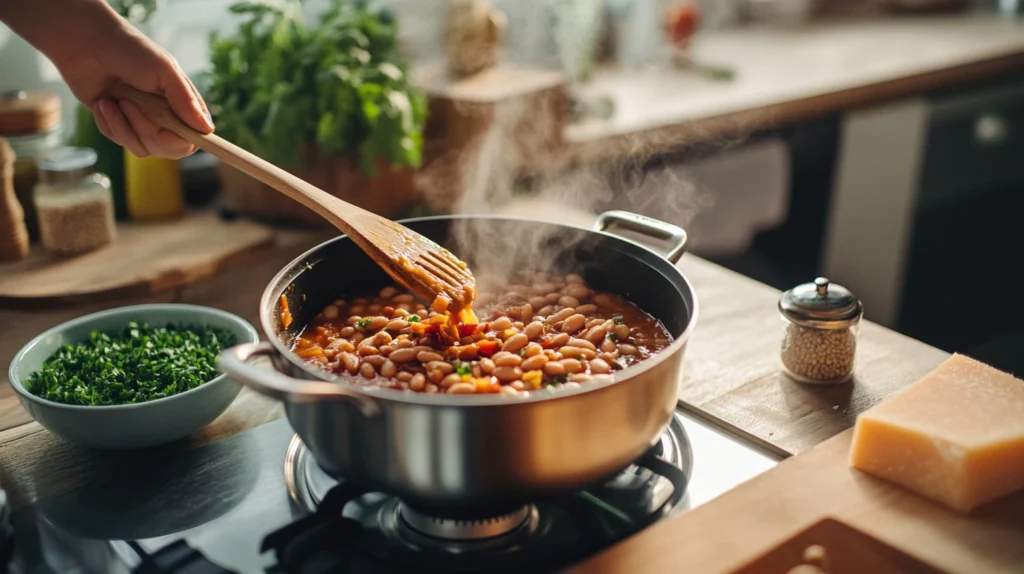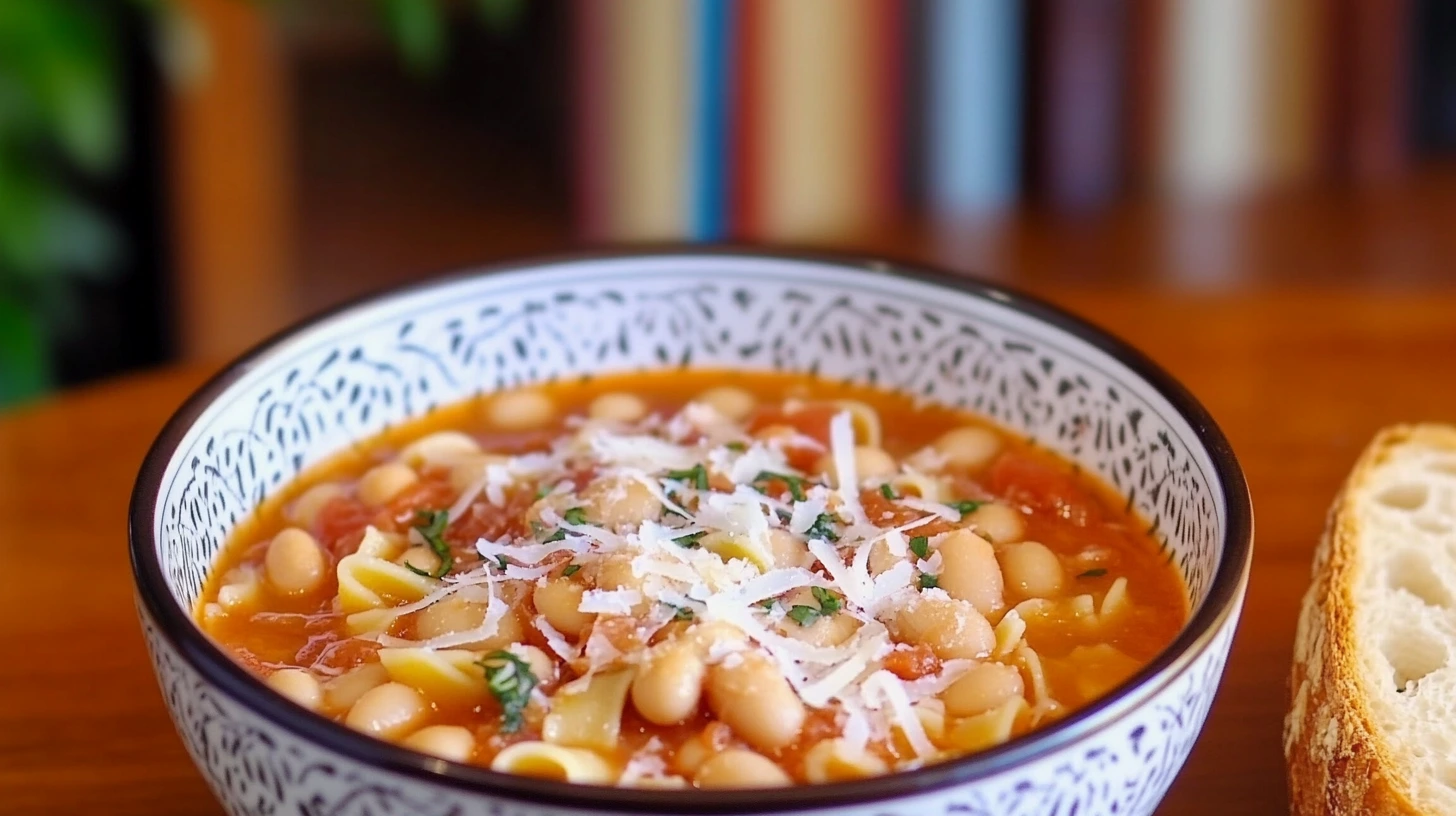Engaging Introduction
Pasta Fagioli, pronounced “pasta fazool” in some Italian-American dialects, is a dish steeped in history and tradition. This humble yet hearty soup translates to “pasta and beans,” reflecting its origins as a peasant dish in rural Italy. Simple ingredients like beans, pasta, and aromatics come together to create a meal that’s as comforting as it is satisfying.
Pasta Fagioli, or ‘pasta and beans,’ is a dish that embodies Italian comfort food. This Traditional Pasta Fagioli Recipe is simple yet rich in flavor, making it a timeless classic for families around the world.
Moreover, Pasta Fagioli embodies the Italian philosophy of cucina povera, or “poor cooking,” which emphasizes making the most of accessible, affordable ingredients. Over the centuries, this dish has evolved, with variations in pasta shapes, beans, and seasonings across different regions of Italy. In addition, its versatility has made it a beloved comfort food worldwide, perfect for warming up on chilly evenings or serving as a hearty family meal.
Furthermore, Pasta Fagioli isn’t just about nourishment; it’s a cultural icon that brings people together. Whether you prefer a creamy texture achieved by blending some of the beans or a brothy consistency with a touch of olive oil, this dish is endlessly customizable. To learn more about the history of Italian cuisine and dishes like this, check out History of Italian Cuisine.
This recipe celebrates the timeless appeal of Pasta Fagioli, offering a taste of Italian heritage that’s easy to recreate in your kitchen.
Ingredients and Required Equipment
For this Traditional Pasta Fagioli Recipe, you’ll need a handful of pantry staples, including beans, pasta, and a mix of fresh vegetables like onions and celery.
Ingredients
- 1 cup ditalini pasta (substitute with elbow macaroni or small shells).
- 1 cup dried cannellini beans (or 1 can, drained and rinsed; substitute with kidney or navy beans).
- 2 tbsp olive oil (for sautéing and drizzling).
- 1 medium onion, finely chopped.
- 2 cloves garlic, minced.
- 1 large carrot, diced.
- 2 stalks celery, diced.
- 1 can (14 oz) diced tomatoes (or use fresh, finely chopped tomatoes).
- 4 cups chicken or vegetable stock (adjust for desired consistency).
- 1 tsp dried oregano (or Italian seasoning).
- Salt and pepper to taste.
- Optional Garnishes: Fresh parsley, grated Parmesan cheese, or red pepper flakes.

Required Equipment
- Large soup pot or Dutch oven.
- Wooden spoon (for stirring).
- Cutting board and knife (for chopping vegetables).
- Colander (for draining beans and pasta).
Tip: For guidance on selecting the best beans for your recipe, explore Healthline’s Guide to Beans and Their Benefits. Additionally, consider experimenting with different pasta shapes to find your favorite combination.
Step-by-Step Guide for Making “Pasta Fagioli”
To prepare this Traditional Pasta Fagioli Recipe, start by soaking your beans overnight to achieve the best texture and ensure even cooking. This step allows the beans to soften and enhances their ability to absorb the flavors of the broth. Additionally, cooking the pasta separately is crucial to maintaining a flavorful broth that isn’t overly starchy or thick. By combining the pasta with the soup just before serving, you’ll preserve the perfect al dente texture that complements the tender beans and aromatic herbs.
1. Prepare the Beans
First, if using dried beans, rinse them thoroughly and soak them overnight in cold water. This reduces cooking time and improves texture. Drain and rinse before using. If using canned beans, simply drain and rinse them under cold water to remove excess sodium.
2. Sauté the Vegetables
Next, heat olive oil in a large soup pot over medium heat. Add the chopped onion, garlic, carrot, and celery. Sauté for 5-7 minutes, stirring occasionally, until the vegetables are softened and fragrant.
3. Build the Soup Base
After that, stir in the diced tomatoes, oregano, salt, and pepper. Cook for another 5 minutes, allowing the flavors to meld. Add the soaked beans and stock to the pot, bringing the mixture to a gentle boil. Reduce heat and simmer for 30-40 minutes, or until the beans are tender.
4. Cook the Pasta
While the soup simmers, cook the pasta separately in salted boiling water until al dente. Drain and set aside. Cooking the pasta separately prevents it from absorbing too much liquid and becoming mushy.

5. Combine and Adjust Consistency
Once the beans are tender, add the cooked pasta to the soup. Stir to combine, and adjust the consistency with additional stock if needed. For a creamier texture, mash a portion of the beans directly in the pot or blend a cup of soup and return it to the pot.
6. Final Touches and Serving
Taste and adjust seasonings with more salt, pepper, or red pepper flakes. Ladle the soup into bowls and garnish with fresh parsley, a drizzle of olive oil, or grated Parmesan cheese.
Tips for Best Results
This Traditional Pasta Fagioli Recipe is all about achieving the perfect balance of flavors and textures. The tender beans, al dente pasta, and aromatic herbs come together to create a dish that’s hearty and satisfying, yet never too heavy. Each spoonful captures the comforting essence of traditional Italian cuisine.
- To achieve a richer flavor, use high-quality olive oil and fresh herbs.
- Let the soup sit for 10-15 minutes before serving to allow the flavors to deepen.
Tips:
- Pair this soup with Homemade Garlic Butter Sauce and crusty bread for a complete meal.
- For another hearty Italian dish, try our Chicken Marsala Fettuccine.
By following these steps, you’ll have a comforting, flavorful bowl of Pasta Fagioli that’s perfect for any occasion. Enjoy!
Tips and Tricks for Perfecting “Pasta Fagioli”
Creating the perfect bowl of Pasta Fagioli requires attention to detail, from the balance of flavors to the ideal consistency. Here are some expert tips to elevate your dish.
Mastering Seasoning
Seasoning is crucial for bringing out the rich flavors of Pasta Fagioli. However, avoid adding too much salt early on, especially if you’re using canned beans or a salty stock. Taste the soup as it simmers and adjust gradually. On the other hand, don’t shy away from fresh herbs like parsley or basil for a fragrant finish. A splash of vinegar or a squeeze of lemon juice before serving can brighten the flavors.
Achieving the Right Texture
The texture of Pasta Fagioli should be hearty but not overly thick. To achieve this, mash or blend a small portion of the beans directly in the pot, which will naturally thicken the broth. However, if the soup becomes too thick, add a little more stock or water to loosen it up. Conversely, for a creamier soup, stir in a dollop of cream or mascarpone.
Balancing Broth and Pasta
Adding pasta directly to the soup may cause it to absorb too much liquid, leading to an overly thick consistency. Cook the pasta separately and stir it in just before serving. This keeps the broth flavorful and the pasta perfectly al dente. Additionally, reserve a bit of the pasta cooking water to adjust the consistency if needed.
By focusing on seasoning, texture, and balance, you’ll create a dish that’s as satisfying as it is flavorful.
Serving and Garnishing “Pasta Fagioli”
Presentation and accompaniments can elevate the enjoyment of a Traditional Pasta Fagioli Recipe. Thoughtful serving ideas and garnishes not only enhance the dish’s flavors but also add visual appeal, making it a feast for both the eyes and the palate
Serving Ideas
Serve Pasta Fagioli in deep bowls to highlight its hearty nature. Likewise, pair it with crusty Italian bread or garlic toast for dipping into the rich broth. For a more complete meal, add a side of roasted vegetables or a crisp Caesar salad. The warmth and comfort of the soup pair beautifully with a glass of Italian red wine, such as Chianti, or a sparkling water with lemon.
Garnishing Tips
Garnishes can transform a simple bowl of Pasta Fagioli into a feast for the senses. Sprinkle grated Parmesan or Pecorino Romano cheese on top for a salty, nutty flavor. Drizzle high-quality extra virgin olive oil for a glossy finish and a hint of richness. Fresh parsley or basil adds a pop of color and a refreshing aroma. Additionally, a pinch of red pepper flakes can add a spicy kick for those who enjoy heat.
To summarize, thoughtful serving and garnishing turn Pasta Fagioli into a truly memorable dish.
Common Mistakes to Avoid
Even a simple dish like Pasta Fagioli can go awry without the right approach. Avoid these common mistakes to ensure your soup is flavorful and perfectly textured.
Undercooked Beans
Cooking beans properly is essential for a creamy and hearty texture. However, dried beans can remain tough if not soaked long enough or cooked thoroughly. To avoid this, soak beans overnight and simmer them until tender. If using canned beans, rinse them well to remove excess sodium and improve flavor. For more tips, consult this guide to cooking beans.
Overly Thick or Thin Broth
Achieving the right consistency can be tricky. If the soup is too thick, gradually add warm stock or water to thin it out. On the other hand, if it’s too watery, mash some of the beans or simmer longer to reduce the liquid. Cooking the pasta separately also helps maintain the desired broth consistency.
Overcooked Pasta
Pasta that’s too soft can make the soup mushy. To avoid this, cook the pasta separately until just al dente and add it to the soup just before serving. Stirring it in earlier may result in it absorbing too much broth and becoming overcooked.
By addressing these issues, you’ll ensure that your Pasta Fagioli is as delicious and satisfying as intended, every time.
FAQ Section for “Pasta Fagioli”
Can I make Pasta Fagioli vegetarian or vegan?
Yes, Pasta Fagioli is highly adaptable for vegetarian or vegan diets. For instance, you can replace chicken stock with vegetable stock for a plant-based base that’s equally rich and flavorful. To mimic the savory depth typically provided by pancetta or bacon, consider adding smoked paprika, sun-dried tomatoes, or even liquid smoke. Additionally, olive oil can play a more prominent role in the dish, adding richness and complexity. You can also include more vegetables, such as zucchini, kale, or spinach, to enhance the heartiness and nutritional value of the soup. Consequently, the dish retains its comforting essence while catering to vegan preferences.
How do I store leftovers for the best taste?
Leftovers are a fantastic way to enjoy Pasta Fagioli for days to come, but proper storage is key to preserving its flavors and texture. Store the soup in an airtight container in the refrigerator for up to 3 days. However, since the pasta may absorb much of the broth and become mushy, it’s best to store the pasta separately if you plan to have leftovers. When reheating, add a bit of broth or water to restore the soup’s original consistency. For longer storage, freeze the soup (without the pasta) for up to 3 months. Thus, you’ll have a quick, hearty meal ready whenever you need it.
What’s the best pasta shape for Pasta Fagioli?
The traditional choice for Pasta Fagioli is ditalini pasta, which is small and tubular, making it perfect for soups. Its size allows it to blend seamlessly with the beans and broth. However, other small pasta shapes, like elbow macaroni or small shells, are excellent alternatives. For instance, small shells are particularly good at holding bits of broth and beans, creating an even more satisfying texture. If you’re gluten-free, consider gluten-free pasta or even zucchini noodles for a low-carb twist. Ultimately, the best choice comes down to personal preference and what you have available in your pantry.
Conclusion for “Pasta Fagioli”
In conclusion, this Traditional Pasta Fagioli Recipe is a timeless dish that truly embodies the essence of Italian cooking: simple, affordable ingredients elevated by thoughtful preparation and bold flavors. Whether you’re enjoying it as a cozy weeknight dinner or serving it to impress guests with a hearty, rustic meal, this soup excels on all fronts. The harmonious combination of tender beans, al dente pasta, and a richly seasoned broth makes it both deeply satisfying and highly nourishing.
All things considered, the beauty of Pasta Fagioli lies in its adaptability. You can customize it to suit dietary needs, whether you prefer a vegetarian version packed with seasonal vegetables or a richer, meaty variation with pancetta or sausage. Experimenting with different herbs, spices, and pasta shapes allows you to put your unique spin on this Italian classic.
Finally, don’t forget to pair this dish with complementary sides to round out the meal. A slice of warm, crusty bread or a crisp salad makes the perfect accompaniment, while a glass of red wine enhances the flavors of the soup. We encourage you to share your Pasta Fagioli creations with friends and family, as well as your feedback with us. Let this classic recipe inspire you to embrace the joy of cooking and the warmth of sharing homemade meals.




